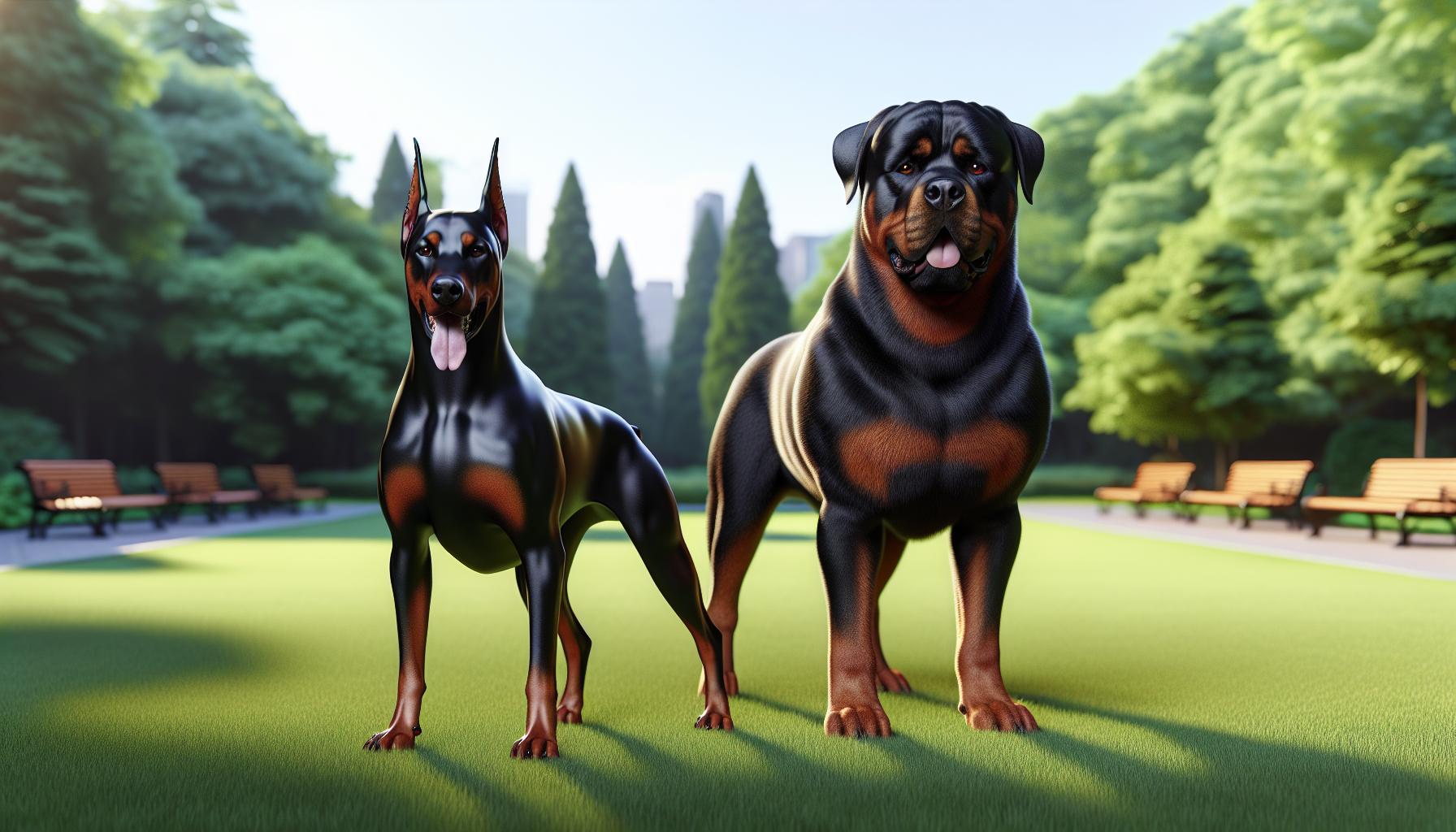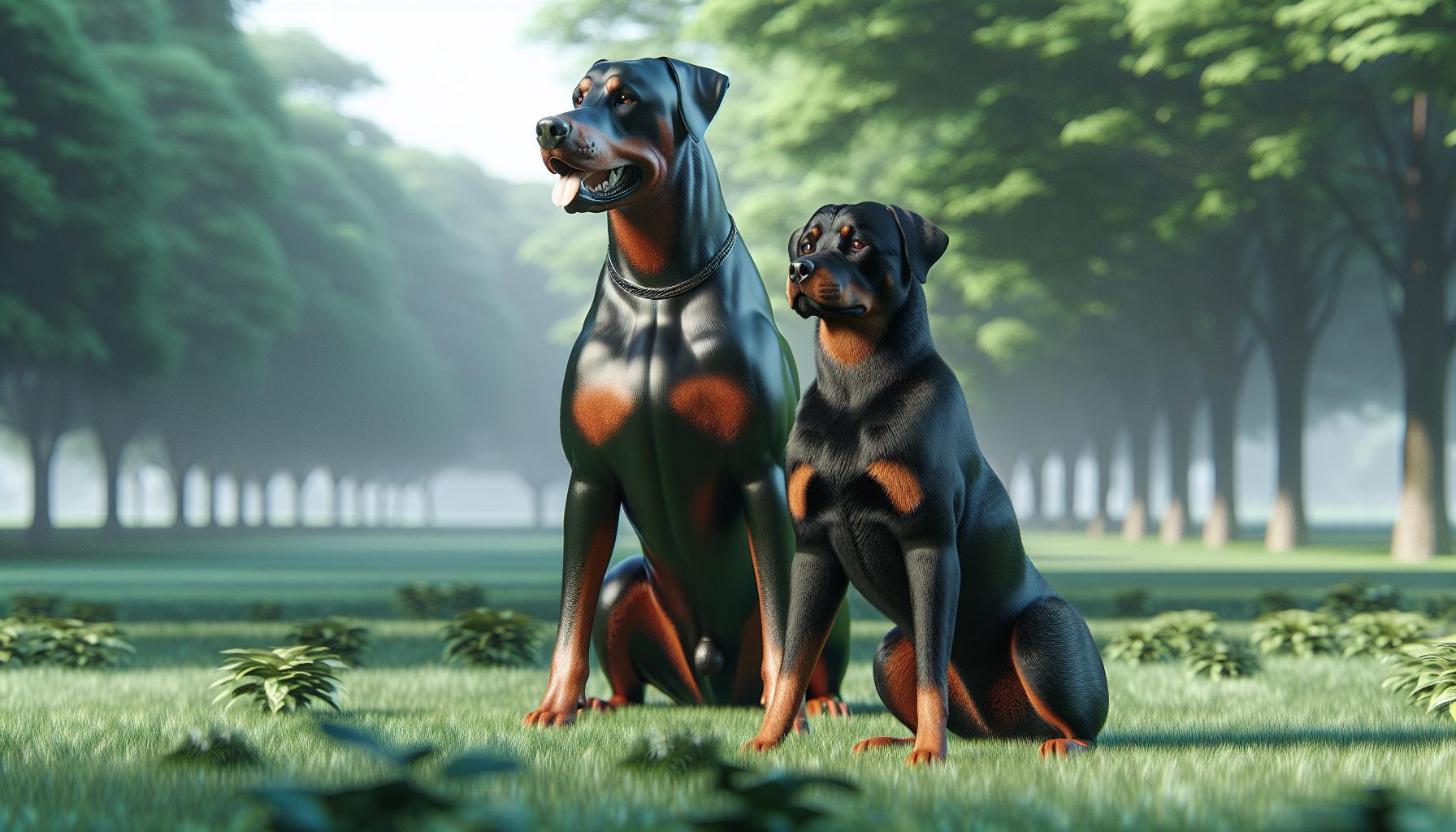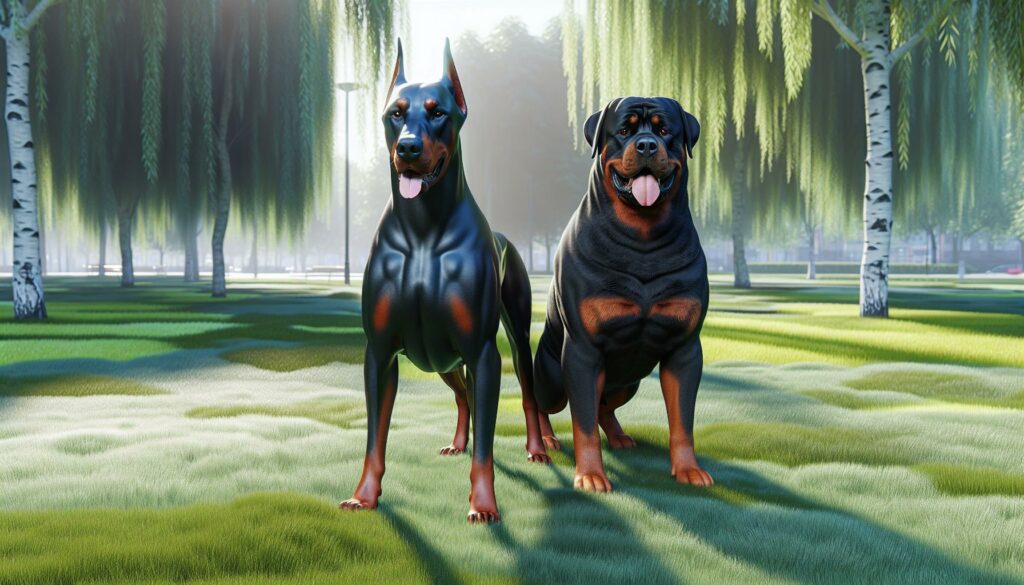As a dog lover and breed enthusiast, I’ve always been fascinated by the striking similarities between Dobermans and Rottweilers. These two powerful breeds often leave people wondering about their differences and which one might make the better pet.
In this article, I’ll dive into the unique characteristics of both Dobermans and Rottweilers, exploring their physical attributes, temperaments, and care requirements. Whether you’re considering adding one of these majestic dogs to your family or simply curious about their distinctions, I’ll provide the insights you need to understand these remarkable breeds better.
Key Takeaways
- Dobermans are high-energy dogs requiring 1-2 hours of daily exercise, while Rottweilers have moderate energy levels needing about 1 hour of activity per day.
- Dobermans have a sleek build and weigh 60-100 pounds, whereas Rottweilers are stockier and heavier at 80-135 pounds.
- Both breeds are intelligent and trainable, with Dobermans excelling in obedience and Rottweilers requiring more consistent training due to their independent nature.
- Dobermans have a low-maintenance coat requiring weekly brushing, while Rottweilers have a double coat needing more frequent grooming, especially during shedding seasons.
- Dobermans typically live 10-12 years and are prone to heart issues, whereas Rottweilers have a slightly shorter lifespan of 8-10 years and are susceptible to joint problems.
Doberman:9tw_uky99hg= Rottweiler
Physical Characteristics
Dobermans and Rottweilers both boast impressive physiques, but their appearances differ significantly. Dobermans have a sleek, muscular build with a long muzzle and erect ears (when cropped). They stand 24-28 inches tall and weigh 60-100 pounds. Rottweilers, on the other hand, have a more robust, stocky build with a broader chest and a shorter muzzle. They’re slightly shorter, standing 22-27 inches tall, but typically heavier, weighing 80-135 pounds.
Temperament and Personality
While both breeds are known for their loyalty and protective instincts, their personalities have distinct nuances. Dobermans are often described as:
- Alert and vigilant
- Highly intelligent and trainable
- Energetic and athletic
- Affectionate with family members
Rottweilers, in contrast, are characterized as:
- Calm and confident
- Protective and territorial
- Strong-willed but trainable
- Patient and gentle with family
Exercise and Training Needs
Both breeds require significant exercise and mental stimulation, but their specific needs differ. Dobermans need:
- 1-2 hours of daily exercise
- Challenging mental tasks
- Consistent, firm training from an early age
Rottweilers require:
- Moderate exercise (1 hour daily)
- Regular socialization
- Patient, consistent training with positive reinforcement
Health Considerations
Each breed has its own set of potential health issues:
| Doberman | Rottweiler |
|---|---|
| Dilated Cardiomyopathy | Hip Dysplasia |
| Von Willebrand’s Disease | Elbow Dysplasia |
| Hip Dysplasia | Osteosarcoma |
| Hypothyroidism | Subvalvular Aortic Stenosis |
Regular vet check-ups and genetic testing are crucial for both breeds to ensure early detection and management of these conditions.
Grooming Requirements
Dobermans have short, smooth coats that require minimal grooming. Weekly brushing and occasional baths suffice. Rottweilers have a double coat that sheds moderately year-round and heavily twice a year. They need more frequent brushing, especially during shedding seasons, to maintain their coat health.
Lifespan and Aging
Dobermans typically live 10-12 years, while Rottweilers have a slightly shorter lifespan of 8-10 years. Both breeds may face age-related issues like joint problems and decreased activity levels as they grow older. Proper nutrition, regular exercise, and preventive healthcare are essential for maintaining their quality of life in their senior years.
Physical Characteristics

Dobermans and Rottweilers have distinct physical features that set them apart. I’ll explore their size, build, coat, and colors to highlight their unique attributes.
Size and Build
Dobermans boast a sleek, muscular build with a height of 24-28 inches and weight of 60-100 pounds. Rottweilers, in contrast, have a stockier frame, standing 22-27 inches tall and weighing 80-135 pounds. Dobermans exhibit a lean, athletic appearance with long legs and a narrow chest. Rottweilers display a more robust, powerful physique with a broad chest and substantial bone structure.
Coat and Colors
Dobermans have a short, smooth coat that’s low-maintenance and sheds minimally. Their coat colors include black, red, blue, and fawn, often with rust-colored markings on the chest, muzzle, and legs. Rottweilers possess a double coat: a short, dense outer coat and a soft undercoat. Their coat is predominantly black with distinct rust or mahogany markings on the cheeks, muzzle, chest, and legs. Rottweilers shed moderately and require more frequent brushing to maintain their coat’s health and appearance.
Temperament and Personality Traits

Both Dobermans and Rottweilers possess distinct temperaments that set them apart from other breeds. I’ll explore the unique personality traits of each breed to help you understand their individual characteristics.
Doberman’s Temperament
Dobermans are known for their intelligence, loyalty, and alertness. They’re:
- Highly trainable, excelling in obedience and various dog sports
- Affectionate with family members, forming strong bonds
- Protective of their loved ones, making excellent guard dogs
- Energetic and playful, requiring mental and physical stimulation
- Sensitive to their owner’s emotions and responsive to positive reinforcement
Dobermans can be aloof with strangers but aren’t typically aggressive when properly socialized. Their intelligence demands consistent training and mental challenges to prevent boredom-induced destructive behavior.
Rottweiler’s Temperament
Rottweilers are calm, confident, and devoted companions. They’re characterized by:
- A steady and self-assured demeanor
- Strong protective instincts towards their family
- Loyalty and affection for their owners
- Intelligence and trainability, responding well to firm, consistent guidance
- A tendency to be reserved with strangers but not inherently aggressive
Rottweilers require early socialization and training to manage their protective nature. They’re generally good with children when raised with them but need supervision due to their size and strength. Rottweilers thrive on human companionship and can become destructive if left alone for extended periods.
Training and Intelligence

Doberman:9tw_uky99hg= Rottweiler are renowned for their high intelligence and trainability, making them popular choices for various roles beyond companionship. I’ve observed that both breeds excel in obedience training, but they have distinct learning styles and motivations.
Dobermans are quick learners with a strong desire to please their owners. They’re highly responsive to positive reinforcement techniques and excel in tasks that require mental stimulation. I’ve found that Dobermans thrive on complex training exercises and can master advanced commands with relative ease. Their intelligence makes them ideal for roles in police work, search and rescue, and competitive obedience trials.
Rottweilers, while equally intelligent, have a more independent nature. They respond well to firm, consistent training methods and respect a confident handler. I’ve noticed that Rottweilers excel in tasks that allow them to use their natural strength and protective instincts. They’re often employed in roles such as guard dogs, therapy animals, and as working dogs in various fields.
Both breeds require early socialization and consistent training to manage their strong personalities. Dobermans benefit from training that challenges their problem-solving abilities, while Rottweilers thrive on tasks that reinforce their role as protectors and working partners.
Here’s a comparison of their training attributes:
| Attribute | Doberman | Rottweiler |
|---|---|---|
| Intelligence Ranking | 5th | 9th |
| Trainability | Excellent | Very Good |
| Motivation | Praise and rewards | Food and praise |
| Best Training Approach | Positive reinforcement | Firm, consistent methods |
| Ideal Training Activities | Agility, scent work, obedience | Protection work, carting, obedience |
I’ve found that both breeds excel in obedience training when started early. Dobermans typically pick up new commands in 5-10 repetitions, while Rottweilers may require 10-15 repetitions for optimal retention. Both breeds benefit from short, focused training sessions lasting 10-15 minutes, repeated 2-3 times daily.
To keep these intelligent breeds mentally stimulated, I recommend incorporating puzzle toys, interactive games, and regular training sessions into their daily routines. This mental exercise is crucial for preventing boredom and potential destructive behaviors in both Dobermans and Rottweilers.
Exercise Requirements and Energy Levels
Dobermans and Rottweilers have distinct exercise needs and energy levels that reflect their breeding history and physical characteristics. I’ll break down the requirements for each breed to help you understand their daily activity needs.
Doberman Exercise Requirements
Dobermans are high-energy dogs that need significant daily exercise:
- 1-2 hours of intense physical activity daily
- Jogging, hiking, or long walks
- Agility training or obstacle courses
- Fetch games or frisbee
- Swimming (with supervision)
Dobermans thrive on mental stimulation alongside physical exercise. I recommend incorporating:
- Obedience training sessions
- Puzzle toys
- Scent work activities
- Hide-and-seek games
Rottweiler Exercise Requirements
Rottweilers have moderate energy levels but still need regular exercise:
- 1 hour of moderate activity daily
- Brisk walks or light jogs
- Weight pulling exercises
- Tug-of-war games
- Swimming (if trained)
Rottweilers benefit from activities that engage their minds:
- Training for guarding or herding tasks
- Food puzzles
- Obedience drills
- Nose work exercises
| Attribute | Doberman | Rottweiler |
|---|---|---|
| Energy Level | High | Moderate |
| Exercise Duration | 1-2 hours daily | 1 hour daily |
| Intensity | High | Moderate |
| Mental Stimulation Needs | Very High | High |
Both breeds require consistent exercise routines to maintain physical and mental well-being. Dobermans typically have higher energy levels and need more intense workouts, while Rottweilers are content with moderate activity. Regular exercise helps prevent obesity, reduces destructive behaviors, and strengthens the bond between dog and owner.
Health Concerns and Lifespan
Dobermans and Rottweilers, while robust breeds, face specific health challenges. I’ll outline the primary health concerns for each breed and their typical lifespans.
Doberman Health Issues
Dobermans are prone to several health conditions:
- Dilated Cardiomyopathy (DCM): A serious heart condition affecting up to 50% of Dobermans.
- von Willebrand’s Disease: A blood clotting disorder common in the breed.
- Hip Dysplasia: Joint malformation causing pain and mobility issues.
- Hypothyroidism: Underactive thyroid gland affecting metabolism.
- Wobbler Syndrome: Spinal cord compression leading to neurological problems.
Rottweiler Health Issues
Rottweilers have their own set of health concerns:
- Hip and Elbow Dysplasia: Joint problems affecting mobility.
- Osteosarcoma: Aggressive bone cancer more common in large breeds.
- Cruciate Ligament Rupture: Knee injury often requiring surgery.
- Aortic Stenosis: Heart condition affecting blood flow.
- Entropion: Eyelid abnormality that can cause eye irritation.
Lifespan Comparison
| Breed | Average Lifespan | Common Age-Related Issues |
|---|---|---|
| Doberman | 10-12 years | Heart problems, cancer, joint issues |
| Rottweiler | 8-10 years | Joint problems, cancer, metabolic disorders |
Dobermans typically live 10-12 years, while Rottweilers have a slightly shorter lifespan of 8-10 years. Both breeds face age-related health challenges, including arthritis, cognitive decline, and increased cancer risk.
Preventive Care
Regular veterinary check-ups, a balanced diet, and appropriate exercise are crucial for both breeds. Early detection and management of health issues can significantly improve quality of life and potentially extend lifespan.
For Dobermans, annual heart screenings are essential due to their predisposition to DCM. Rottweilers benefit from regular joint assessments to monitor for dysplasia and other mobility issues.
By understanding these health concerns and implementing preventive care measures, owners can help ensure their Doberman or Rottweiler leads a healthy, comfortable life.
Suitability as Family Pets
When considering Dobermans and Rottweilers as family pets, I’ve found that both breeds can be excellent companions when properly trained and socialized. However, their suitability varies depending on the family’s lifestyle and experience with dogs.
Dobermans are known for their:
- Strong bonds with family members
- High energy levels requiring regular exercise
- Intelligence and trainability
- Protective nature balanced with affection
Rottweilers excel in:
- Calm and steady demeanor
- Loyalty to their family
- Patience with children when properly socialized
- Adaptability to various living situations
For families with children, Rottweilers often have an edge due to their patient nature. However, supervision is crucial due to their size and strength. Dobermans can be great with kids too, but their high energy might be overwhelming for very young children.
Here’s a comparison of family-friendly traits:
| Trait | Doberman | Rottweiler |
|---|---|---|
| Child-friendly | Good with proper training | Excellent with supervision |
| Apartment living | Moderate suitability | Good suitability |
| Novice owner friendly | Challenging | Moderate |
| Affection level | High | Moderate to High |
| Watchdog ability | Excellent | Excellent |
Both breeds require early socialization to ensure they’re well-adjusted around strangers and other pets. Dobermans need more mental stimulation and physical activity, making them ideal for active families. Rottweilers, with their moderate energy levels, can adapt well to less active households.
I’ve observed that Dobermans tend to be more velcro dogs, often seeking close contact with their owners. Rottweilers, while affectionate, are generally more independent. This makes Dobermans potentially better suited for families wanting a constant companion, while Rottweilers might appeal to those preferring a more self-reliant dog.
For first-time dog owners, Rottweilers are often easier to handle due to their calmer nature. Dobermans’ high energy and intelligence can be challenging for inexperienced owners. Both breeds respond well to consistent, positive reinforcement training methods.
In terms of space requirements, Rottweilers adapt better to smaller living spaces due to their lower energy levels. Dobermans, however, need more room to move and exercise, making them better suited for homes with yards.
Ultimately, the suitability of either breed as a family pet depends on the family’s ability to meet the dog’s needs for exercise, training, and socialization. With proper care and attention, both Dobermans and Rottweilers can become loyal, loving, and protective family members.
Working Roles and Capabilities
Dobermans and Rottweilers excel in various working roles due to their intelligence, strength, and loyalty. I’ve observed that both breeds have impressive capabilities that make them valuable in different professional capacities.
Doberman Working Roles
Dobermans are versatile workers, often employed in:
- Police and military service
- Search and rescue operations
- Personal protection
- Therapy and assistance roles
Their agility, speed, and keen sense of smell make them exceptional in tracking and apprehension tasks. Dobermans’ intelligence allows them to quickly learn complex commands, making them ideal for specialized roles in law enforcement and security.
Rottweiler Working Roles
Rottweilers are known for their strength and protective instincts, commonly used in:
- Guard and security work
- Police and military service
- Therapy and assistance roles
- Herding and carting
Their imposing presence and unwavering loyalty make Rottweilers excellent guard dogs. Their strength and endurance also suit them for tasks like pulling carts or assisting in heavy-duty rescue operations.
Comparison of Working Capabilities
| Attribute | Doberman | Rottweiler |
|---|---|---|
| Speed | Faster | Moderate |
| Strength | High | Very High |
| Agility | Excellent | Good |
| Scent Work | Highly Capable | Capable |
| Endurance | High | Very High |
Dobermans typically outperform Rottweilers in speed and agility-based tasks, while Rottweilers excel in strength-intensive roles. Both breeds demonstrate exceptional capabilities in protection and service-oriented work.
Training for Working Roles
Training Dobermans for working roles focuses on:
- Harnessing their natural alertness
- Refining their scent detection skills
- Enhancing their agility for pursuit tasks
Rottweiler training emphasizes:
- Channeling their protective instincts
- Developing their strength for physical tasks
- Reinforcing their calm demeanor for controlled responses
Both breeds require consistent, positive reinforcement-based training to excel in their working roles. Early socialization is crucial to ensure they remain confident and stable in various environments.
Adaptability to Different Work Environments
Dobermans adapt well to:
- Fast-paced, high-intensity work environments
- Roles requiring quick decision-making
- Tasks involving frequent location changes
Rottweilers thrive in:
- Stationary guard positions
- Roles requiring intimidating presence
- Work involving strength and stamina
Understanding these breed-specific traits helps in assigning the most suitable working roles, maximizing their natural abilities and ensuring their success in professional capacities.
Grooming and Maintenance Needs
Dobermans and Rottweilers have distinct grooming requirements due to their different coat types. I’ll break down the grooming needs for each breed to help you understand the maintenance involved.
Doberman Grooming
Dobermans have a short, smooth coat that’s relatively low-maintenance:
- Brushing: Weekly brushing with a soft-bristled brush or grooming mitt
- Bathing: Every 6-8 weeks or as needed
- Nail trimming: Every 2-3 weeks
- Ear cleaning: Weekly to prevent infections
- Teeth brushing: 2-3 times per week
Rottweiler Grooming
Rottweilers have a double coat that requires more attention:
- Brushing: 2-3 times per week, daily during shedding seasons
- Bathing: Every 6-8 weeks or as needed
- Nail trimming: Every 2-3 weeks
- Ear cleaning: Weekly to prevent infections
- Teeth brushing: 2-3 times per week
Shedding Comparison
| Breed | Shedding Level | Frequency of Heavy Shedding |
|---|---|---|
| Doberman | Low to Moderate | Year-round |
| Rottweiler | Moderate | Twice a year |
Maintenance Tips
For both breeds:
- Use breed-specific shampoos to maintain coat health
- Regularly check for skin issues, lumps, or abnormalities
- Keep their living area clean to reduce shedding impact
- Provide a balanced diet to promote coat health
Dobermans require less grooming time overall, while Rottweilers need more frequent brushing to manage their double coat. Regular grooming sessions for both breeds offer an opportunity to bond and check for any health concerns.
Choosing Between a Doberman and a Rottweiler
Selecting the right breed for your lifestyle is crucial. I’ll break down key factors to consider when choosing between a Doberman and a Rottweiler:
Activity Level:
- Doberman: High-energy, requires 1-2 hours of intense daily exercise
- Rottweiler: Moderate energy, needs about 1 hour of daily activity
Living Space:
- Doberman: Adapts well to apartments with sufficient exercise
- Rottweiler: Prefers larger spaces but can adapt to apartments with proper exercise
Family Compatibility:
- Doberman: Forms strong bonds, great for active families
- Rottweiler: Patient with children, suitable for various family types
Training Needs:
- Doberman: Highly trainable, excels in obedience
- Rottweiler: Intelligent but independent, requires consistent training
Protective Instincts:
- Doberman: Alert and protective, may be aloof with strangers
- Rottweiler: Strong guarding instincts, calm demeanor
Grooming Requirements:
- Doberman: Low maintenance, weekly brushing
- Rottweiler: Moderate maintenance, brushing 2-3 times weekly
Health Considerations:
- Doberman: Prone to heart issues, 10-12 year lifespan
- Rottweiler: Susceptible to joint problems, 8-10 year lifespan
- Doberman: Excels in agility and speed-based tasks
- Rottweiler: Superior strength, ideal for guard work
| Factor | Doberman | Rottweiler |
|---|---|---|
| Energy Level | High | Moderate |
| Exercise Needs | 1-2 hours daily | 1 hour daily |
| Trainability | Highly trainable | Trainable, independent |
| Grooming | Low maintenance | Moderate maintenance |
| Lifespan | 10-12 years | 8-10 years |
Consider your lifestyle, experience with dogs, and ability to meet each breed’s needs. Both Dobermans and Rottweilers make loyal companions when properly trained and socialized.
Excellent Companions
Doberman:9tw_uky99hg= Rottweiler exceptional breeds with unique qualities. Both offer loyalty strength and intelligence making them excellent companions for the right families. Their distinct characteristics cater to different lifestyles and preferences.
Choosing between these breeds depends on your specific needs activity level and experience with dogs. Whether you’re drawn to the sleek athleticism of a Doberman or the sturdy power of a Rottweiler proper training socialization and care are essential.
Ultimately the decision comes down to which breed aligns best with your lifestyle and expectations. Both Dobermans and Rottweilers have the potential to be loving protective family members when given the right environment and attention.




